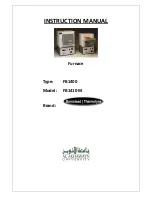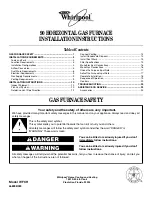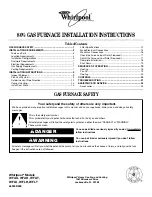
441 01 2314 06
Specifications are subject to change without notice.
16
Piping with Street Elbows
1. Assemble the elbows so that the outlet of one(1) elbow is 90
°
from the inlet of the other. The elbows should be tight enough
to be leak proof. An additional
1
/
4
turn will be required at the
end of step 2, see
Figure 8
.
2. Screw elbow assembly into gas valve far enough to be leak
proof. Position elbow assembly so that the inlet of the elbow is
at the bottom of the gas valve. An additional
1
/
2
turn will be re-
quired in step 3. Turn open end of inlet elbow to face the right
side of the furnace (
1
/
4
turn), see
Figure 9
.
3. Turn assembly an additional
3
/
8
turn to position inlet near the
top of the gas valve and in line with gas opening on right side of
furnace, see
Figure 7
and
Figure 10
.
Figure 8
25
−
23
−
23c
Elbows (*8DNL)
Figure 9
Gas Valve with Elbows (*8DNL)
Representative drawing only, some models may vary in appearance.
Figure 10
Gas Valve with Elbows (*8DNL)
Representative drawing only, some models may vary in appearance.
4. Gas supply line then can be run directly into opening of elbow.
Piping with Close Nipples and Standard Elbows
1. Assemble elbows and nipples similar to street elbows shown
in
Figure 8
.
2. Follow steps 2 through 4
Piping with Street Elbows.
FIRE OR EXPLOSION HAZARD
Failure to follow this warning could result in
personal injury, death and/or property damage.
A flexible corrugated metal gas connector must be
properly installed, shall not extend through the side
of the furnace, and shall not be used inside the
furnace.
Black iron pipe shall be installed at the furnace gas
control valve and extend a minimum of 2
(50.8mm)
outside furnace.
!
WARNING
Additional Propane Piping Requirements
•
Have a licensed Propane gas dealer make all connections at
storage tank and check all connections from tank to furnace.
•
If copper tubing is used, it
MUST
comply with limitation set in
local codes, or in the absence of local codes, the gas codes of
the country having jurisdiction.
•
Two
−
stage regulation of Propane gas is recommended.
FIRE OR EXPLOSION HAZARD
Failure to follow this warning could result in
personal injury, death and/or property damage.
A natural gas or Propane gas leak ignited by an
open flame or spark could result in personal injury,
death and/or property damage.
Natural gas is lighter than air and will rise. Propane
gas is heavier than air and will settle and remain in
low areas and open depressions.
Thoroughly ventilate area and dissipate gas. Do
NOT use a match or open flame to test for leaks, or
attempt to start up furnace before thoroughly
ventilating area.
!
WARNING
Final Check
•
Test all pipes for leaks.
•
If orifices were changed, make sure they are checked for
leaks.
•
During pressure testing of gas supply piping system:
a. If test pressure does not exceed
1
/
2
psi (24 pa), isolate the
furnace from the gas supply piping system by closing the
equipment shutoff valve.
b. If test pressure exceeds
1
/
2
psi (24 pa), the furnace and its
manual equipment shutoff valve must be disconnected
from the gas supply piping system.
•
To check for leaks apply soap suds or a liquid detergent to
each joint. Bubbles forming indicate a leak.
•
Do not use an open flame to test for gas leaks. Fire or explo-
sion could occur.
•
Correct even the smallest leak at once.
















































